Picture |
Object
name
#NORAD |
Description |
Mission
Date |
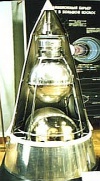


|
Sputnik
2
Sputnik II
Physical lab
PS 2
#00003
(1957-002A)
(1957 Beta 1) |
 Sputnik
2 was the first spaceship which brought an animal in
space. The elliptical orbit had an apogee of 1770 km
and an apogee of 320 km. Sputnik II circulated the Earth
in 103,7 minutes. Sputnik
2 was the first spaceship which brought an animal in
space. The elliptical orbit had an apogee of 1770 km
and an apogee of 320 km. Sputnik II circulated the Earth
in 103,7 minutes.
Sputnik 2 was a three-part conical
satellite with a hight of 1.2m and was comprised of
the following sections:
- a cylindrical container
for scientific equipment
- a spherical container
for batteries, 2 transmitters and radiotelemetry systems
- a sealed cabin for the a dog named Laika
Laika
lived for one week and part of the downlink telemetry
was her heartbeat. She died on November 10th
1957 when oxygen in her capsule was exhausted.
Sputnik II transmitted for 7 days on the frequencies
20.005 MHz and 40.010 MHz.
Sputnik 2 decayed on
April 14th 1958. This recording
was provided by Alois DL3PD/SK.
|
Nov 3rd 1957 |
 Enclosed
is the recording of the heartbeat of the dog Laika aboard
Sputnik 2. The recording is from vinyl no. 2 which was
included in the Italian Enciclopaedia L置omo e lo spazio
(The man and the space) issued 1965 by Fratelli Fabbri.
Digitized and kindly provided by Federico Manzini. Enclosed
is the recording of the heartbeat of the dog Laika aboard
Sputnik 2. The recording is from vinyl no. 2 which was
included in the Italian Enciclopaedia L置omo e lo spazio
(The man and the space) issued 1965 by Fratelli Fabbri.
Digitized and kindly provided by Federico Manzini.
|
  In June
2010 I received from Dick W4PUJ/SK In June
2010 I received from Dick W4PUJ/SK
(ex WA4DGU) together
with a number of other unique audio recordings enclosed
recording of Sputnik II. Thanks Dick for providing this
recording. Dick became silent key on February 14th
2012.
|
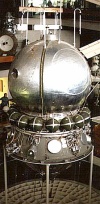
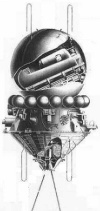
|
Sputnik
4
Sputnik IV
Korabl-Sputnik 1
1960-005A
#00034 |
Sputnik 4 (also called
Korabl-Sputnik 1) was launched from former U.S.S.R from
Baykonur Cosmodrome into an elliptical orbit with an
apogee of 675 km and a perigee of 280 km.
This first
of a series of spacecraft used to investigate the means
for manned space flight, contained scientific instruments,
a television system, and a self-sustaining biological
cabin with a dummy of a man. The spacecraft was designed
to study the operation of the life support system and
the stresses of flight. The spacecraft radioed both
extensive telemetry and prerecorded voice communications.
After four days of flight, the reentry cabin was separated
from its service module and retro-rockets were fired,
but because of an incorrect attitude the spacecraft
did not reenter the atmosphere. |
May 15th
1960 |
 This recording
of Sputnik IV was kindly provided by Dick Daniels W4PUJ/SK. This recording
of Sputnik IV was kindly provided by Dick Daniels W4PUJ/SK.
|

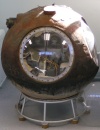
|
Sputnik
5
Sputnik V
Korabl Sputnik 2
1960-011A
#00055 |
Sputnik 5 (also called
Korabl-Sputnik 2) was launched from former U.S.S.R from
Baykonur Cosmodrome into an elliptical orbit with an
apogee of 325 km and a perigee of 287 km.
This spacecraft
was the second in a series of spacecraft designed to
further the development of an Earth orbiting system
for the planned manned space program.
The spacecraft
carried two dogs, Strelka (eng. arrow, deut. Pfeil)
and Belka (eng. squirrel, deut. Eichhörnchen),
plus a grey rabbit, rats, mice, flies, plants, fungi,
microscopic water plants, and seeds. Sputnik 5 returned
telemetry and TV images showing the dogs' physical condition.
Reported transmission frequencies were 19.995
MHz and 83 MHz.
After a one day flight, the spacecraft
and both dogs were successfully recovered. Strelka (see
right picture) and Belka became the first living creatures
to orbit the Earth and return safely. |
Aug 19th
1960 |
 This recording
of the telemetry of Sputnik V was recorded on 19.995
MHz bey an unknown source. Recording kindly provided
by John Pate W1XQ. This recording
of the telemetry of Sputnik V was recorded on 19.995
MHz bey an unknown source. Recording kindly provided
by John Pate W1XQ.
|

|
Vostok-3 No.1
Sputnik
9
Korabl Sputnik 4
1961-008A
#00091 |
 This
Space Ship Vostok-3 No.1 carried a dog named Chernuska
in space. Besides Chernuska also onboard was a dummy
cosmonaut, mice and a guinea pig. The flight lasted
for a single orbit, and a successful recovery was made.
Recording provided by Alois DL3PD/SK. This
Space Ship Vostok-3 No.1 carried a dog named Chernuska
in space. Besides Chernuska also onboard was a dummy
cosmonaut, mice and a guinea pig. The flight lasted
for a single orbit, and a successful recovery was made.
Recording provided by Alois DL3PD/SK.
|
Mar 9th
1961 |
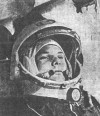

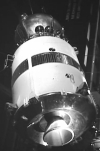
|
Russian
Spaceship
Vostok 1
1961-012A
#00103
(crew: Jurij Gagarin) |
 The first
man in space: Jurij Gagarin. He circulated the Earth
in his Russian Spaceship Vostok 1 during his flight
which had a duration of 108 minutes. Recording provided
by Alois DL3PD/SK. The first
man in space: Jurij Gagarin. He circulated the Earth
in his Russian Spaceship Vostok 1 during his flight
which had a duration of 108 minutes. Recording provided
by Alois DL3PD/SK.
|
Apr
12th
1961 |
 Vinyl
single made in USSR Vinyl
single made in USSR
"12-IV 1961 CCCP Gagarin"
side 1 with Russian comments. Recording provided by
Maik Hermenau.
|
 Vinyl
single made in USSR Vinyl
single made in USSR
"12-IV 1961 CCCP Gagarin"
side 2 with German comments. Recording provided by Maik
Hermenau.
|
 Colorvox
"Schallbildkarte" Colorvox
"Schallbildkarte"
"Reportage über
den Weltraumflug Juri Gagarins". Recording provided
by Maik Hermenau.
|
 Report
in German language about the phase between the first
artificial satellite Sputnik 1 and the first man in
space Juri Gagarin. From a Schallfolie "Der Weg
in den Kosmos" which was provided in the 60s by
a Eastern German magazine called "Frösi".
Recording provided by Maik Hermenau. Report
in German language about the phase between the first
artificial satellite Sputnik 1 and the first man in
space Juri Gagarin. From a Schallfolie "Der Weg
in den Kosmos" which was provided in the 60s by
a Eastern German magazine called "Frösi".
Recording provided by Maik Hermenau.
|
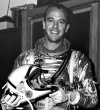
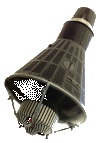
|
US
Spaceship
Freedom 7
MR-3
MERCR3
(crew: Alan B. Shepard Jr.) |
 Alan B.
Shepard Jr. (1924-1998) was the first American in space.
His flight in a Mercury capsule on top of a Redstone-MRLV
rocket had a duration of 15 minutes and 28 seconds.
As this was a ballistic suborbital flight reaching an
altitude of 187 km it did not get a International nor
a NORAD designator. His recovery at sea was viewed on
live TV. 10 years later Al Shepard was the commander
of Apollo 14 and landed on the Moon. Alan B.
Shepard Jr. (1924-1998) was the first American in space.
His flight in a Mercury capsule on top of a Redstone-MRLV
rocket had a duration of 15 minutes and 28 seconds.
As this was a ballistic suborbital flight reaching an
altitude of 187 km it did not get a International nor
a NORAD designator. His recovery at sea was viewed on
live TV. 10 years later Al Shepard was the commander
of Apollo 14 and landed on the Moon.
|
May
5th 1961 |
  These
recording are from vinyls no. 24 and no. 25 which were
included in the Italian Enciclopaedia L置omo e lo spazio
(The man and the space) issued 1965 by Fratelli Fabbri.
They include sequences of the launch campaign as well
as Shepard's voice while he was in orbit ("What
a beautiful view ..."). Digitized and kindly provided
by Federico Manzini. These
recording are from vinyls no. 24 and no. 25 which were
included in the Italian Enciclopaedia L置omo e lo spazio
(The man and the space) issued 1965 by Fratelli Fabbri.
They include sequences of the launch campaign as well
as Shepard's voice while he was in orbit ("What
a beautiful view ..."). Digitized and kindly provided
by Federico Manzini.
|
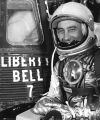
|
Liberty
Bell 7
MR-4
MERCR4
(crew: Virgil Ivan
"Gus" Grissom) |
Virgil Ivan "Gus"
Grissom (1926-1967) was the second American in space.
His flight in a Mercury Redstone 4 (MR-4) had a duration
of 15 minutes and 37 seconds. The main configuration
differences from the MR-3 spacecraft was the addition
of a large viewing window and an explosively actuated
side hatch (which actually failed during landing). As
this was a ballistic suborbital flight reaching an altitude
of 187 km it did not get a International nor a NORAD
designator. |
July
21st 1961 |
 This recording
is from vinyl no. 27 which was included in the Italian
Enciclopaedia L置omo e lo spazio (The man and the space)
issued 1965 by Fratelli Fabbri. They include sequences
of the launch campaign as well as Shepard's voice while
he was in orbit ("What a beautiful view ...").
Digitized and kindly provided by Federico Manzini. This recording
is from vinyl no. 27 which was included in the Italian
Enciclopaedia L置omo e lo spazio (The man and the space)
issued 1965 by Fratelli Fabbri. They include sequences
of the launch campaign as well as Shepard's voice while
he was in orbit ("What a beautiful view ...").
Digitized and kindly provided by Federico Manzini.
|
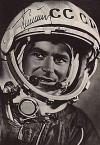
|
Russian
Spaceship
Vostok 2
Sputnik 12
1961-019A
#00168
(crew: Gherman S. Titov) |
 Russian
Spaceship Vostok 2 (3KA-4) with cosmonaut Gherman S.
Titov was launched by a Vostok rocket from Baikonur
(U.S.S.R.) into an 166x232 km orbit with 65° inclination.
The flight lasted 1 day and 1 hour during with G.S.
Titov circulated the earth 17 times. Russian
Spaceship Vostok 2 (3KA-4) with cosmonaut Gherman S.
Titov was launched by a Vostok rocket from Baikonur
(U.S.S.R.) into an 166x232 km orbit with 65° inclination.
The flight lasted 1 day and 1 hour during with G.S.
Titov circulated the earth 17 times.
|
Aug
6th 1961 |
 This recording
is from vinyl no. 28 which was included in the Italian
Enciclopaedia L置omo e lo spazio (The man and the space)
issued 1965 by Fratelli Fabbri. It includes multiple
recordings of Titov's voice while he was in orbit. Digitized
and kindly provided by Federico Manzini. This recording
is from vinyl no. 28 which was included in the Italian
Enciclopaedia L置omo e lo spazio (The man and the space)
issued 1965 by Fratelli Fabbri. It includes multiple
recordings of Titov's voice while he was in orbit. Digitized
and kindly provided by Federico Manzini.
|
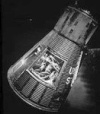
|
US Spaceship
Friendship 7
Mercury Atlas 6
1962-003A
#00240
(crew: John Glenn) |
 Report
in German language about the first US astronaut John
Glenn circulating in MA 6 (Mercury Atlas 6) the Earth
3 times. Heftbeilage der Hauszeitschrift "Die Brücke"
Nr.2 vom Oktober 1962 der Pharmazeutischen Medizinischen
Abteilung der Farbwerke Hoechst AG. Recording provided
by Maik Hermenau. Report
in German language about the first US astronaut John
Glenn circulating in MA 6 (Mercury Atlas 6) the Earth
3 times. Heftbeilage der Hauszeitschrift "Die Brücke"
Nr.2 vom Oktober 1962 der Pharmazeutischen Medizinischen
Abteilung der Farbwerke Hoechst AG. Recording provided
by Maik Hermenau.
|
Feb 20th 1962 |
 The voice
of John Glenn "Roger, zero G and I feel fine, capsule
is turning around". Recording courtesy of NASA. The voice
of John Glenn "Roger, zero G and I feel fine, capsule
is turning around". Recording courtesy of NASA.
|
 The voice
of John Glenn "God speed, John Glenn!". Recording
courtesy of NASA. The voice
of John Glenn "God speed, John Glenn!". Recording
courtesy of NASA.
|

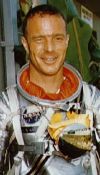
|
Mercury
Atlas 7
MA-7
Aurora 7
1962-019A
#00295
(crew: M. Scott Carpenter) |
Mercury Atlas 7 (MA-7)
was the second orbital flight of an American rocket. |
May 24th 1962 |
 A curious
event which occurred during Glenn's (MA-6) flight was
his report of "fire flies" when he entered
the sunrise portion of an orbit. Although this phenomenon
was a mystery at the time, it was resolved during the
flight of Mercury Atlas 7 when Scott Carpenter accidentally
tapped the wall of the spacecraft with his hand, releasing
many of the so-called "fire flies". The source
was determined to be frost from the reaction control
jets. You can hear his respective report "I have
the fire flies"enclosed. Recording courtesy of
NASA. A curious
event which occurred during Glenn's (MA-6) flight was
his report of "fire flies" when he entered
the sunrise portion of an orbit. Although this phenomenon
was a mystery at the time, it was resolved during the
flight of Mercury Atlas 7 when Scott Carpenter accidentally
tapped the wall of the spacecraft with his hand, releasing
many of the so-called "fire flies". The source
was determined to be frost from the reaction control
jets. You can hear his respective report "I have
the fire flies"enclosed. Recording courtesy of
NASA.
|
 Scott
Carpenter greeting: "Hola, amigos, felicitaciones
a Mexico y especialmente a mi amigos de Guaymas."
Recording courtesy of NASA. Scott
Carpenter greeting: "Hola, amigos, felicitaciones
a Mexico y especialmente a mi amigos de Guaymas."
Recording courtesy of NASA.
|
 Enclosed
are multiple parts of recordings of Scott Carpenter
aboard Aurora 7. Thes are from vinyl no. 44 which was
included in the Italian Enciclopaedia L置omo e lo spazio
(The man and the space) issued 1965 by Fratelli Fabbri.
Digitized and kindly provided by Federico Manzini. Enclosed
are multiple parts of recordings of Scott Carpenter
aboard Aurora 7. Thes are from vinyl no. 44 which was
included in the Italian Enciclopaedia L置omo e lo spazio
(The man and the space) issued 1965 by Fratelli Fabbri.
Digitized and kindly provided by Federico Manzini.
|
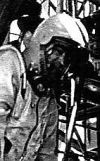
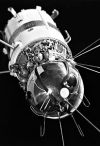
|
Russian
Spaceship
Vostok 3
1962 Alpha Mu 1
1962-036A
#00363
(crew: Andriyan G. Nikolayev) |
Russian Spaceship Vostok
3 with cosmonaut Andriyan G. Nikolayev was launched
by a modified SS6 rocket from Baikonur (U.S.S.R.) into
an 183x251 km orbit with 65° inclination. The flight
lasted 4 days during with Andriyan G. Nikolayev circulated
the earth 64 times. Vostok 3 featured a tracking beacon
on 19.995 MHz and further transmitters on 20.006 MHz
and 143.625 MHz. |
Aug
11th 1962 |
 This set
of recording is from vinyl no. 48 which was included
in the Italian Enciclopaedia L置omo e lo spazio (The
man and the space) issued 1965 by Fratelli Fabbri. It
includes recordings of Nikolayev's voice while he was
in orbit. Digitized and kindly provided by Federico
Manzini. This set
of recording is from vinyl no. 48 which was included
in the Italian Enciclopaedia L置omo e lo spazio (The
man and the space) issued 1965 by Fratelli Fabbri. It
includes recordings of Nikolayev's voice while he was
in orbit. Digitized and kindly provided by Federico
Manzini.
|
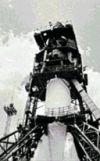
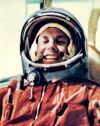
|
Russian
Spaceship
Vostok 4
1962-037A
#00365
(crew: Pavel R. Popovich) |
Russian Spaceship Vostok
4 with cosmonaut Pavel R. Popovich was launched by a
modified SS6 rocket from Baikonur (U.S.S.R.) into an
180x254 km orbit with 65° inclination. The flight
lasted 4 days during with Pavel R. Popovich circulated
the earth 48 times. Vostok 4 featured a tracking beacon
on 19.990 MHz and further transmitters on 20.006 MHz
and 143.625 MHz. Vostok 3 and 4 conducted the first
group flight in cosmic space. |
Aug
12th 1962 |
 This set
of recording is from vinyl no. 49 which was included
in the Italian Enciclopaedia L置omo e lo spazio (The
man and the space) issued 1965 by Fratelli Fabbri. It
includes multiple recordings of Popovich's voice while
he was in orbit. Digitized and kindly provided by Federico
Manzini. This set
of recording is from vinyl no. 49 which was included
in the Italian Enciclopaedia L置omo e lo spazio (The
man and the space) issued 1965 by Fratelli Fabbri. It
includes multiple recordings of Popovich's voice while
he was in orbit. Digitized and kindly provided by Federico
Manzini.
|
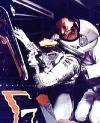
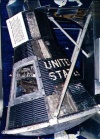
|
Mercury
Atlas 8
MA 8
Sigma 7
1962-052A
#00433
(crew: Walter "Wally" M. Schirra) |
Mercury
Atlas 8 (MA-8, also Sigma 7) was the third manned orbital
flight of the Mercury program. The pilot was Walter
M. Schirra, Jr. who called his mission a "textbook
flight", the only difficulty having been attaining
the correct temperature adjustment on his pressure suit.
The launch which was postponed twice was the first to
be relayed live (via the Telstar satellite) to television
audiences in Western Europe.
This spacecraft featured
the addition of two high-frequency antennas (mounted
on the retro package) to assist and maintain spacecraft
and ground communications throughout the flight.
Four experiments were conducted as a part of the MA-8
flight. One was a light visibility experiment, similar
to those conducted on the two previous missions. The
second was a nuclear radiation experiment, in which
radiation-sensitive emulsions were used to study the
flux and composition of galactic cosmic rays. A third
was an investigation, in which the ablation of various
materials due to heating during reentry was measured.
The final experiment used a 70 mm Hasselblad camera
with various filters to gather imagery for assembling
a catalog of Earth photography for comparison with similar
images obtained by other satellite programs.
The
flight was 9 hours 13 minutes and 11 seconds during
which Schirra travelled over 230,000 km (completing
six orbits) and finally the capsule reentered landing
440 km northeast of Midway Island in the Pacific Ocean. |
Oct.
3rd 1962 |
 Enclosed
voice transmission of astronaut Walter Schirra onboard
Mercury-Atlas-8 was received on 15.016 MHz on October
3rd 1962 by R.S. (Dick) Flagg
in Vermont. Enclosed
voice transmission of astronaut Walter Schirra onboard
Mercury-Atlas-8 was received on 15.016 MHz on October
3rd 1962 by R.S. (Dick) Flagg
in Vermont.
|
  These
recordings are from vinyls no. 54 & 55 which were
included in the Italian Enciclopaedia L置omo e lo spazio
(The man and the space) issued 1965 by Fratelli Fabbri.
They include multiple recordings of Walter Schirra's
voice while he was in orbit as well as the launch campaign.
The comments are in Italian language. Digitized and
kindly provided by Federico Manzini. These
recordings are from vinyls no. 54 & 55 which were
included in the Italian Enciclopaedia L置omo e lo spazio
(The man and the space) issued 1965 by Fratelli Fabbri.
They include multiple recordings of Walter Schirra's
voice while he was in orbit as well as the launch campaign.
The comments are in Italian language. Digitized and
kindly provided by Federico Manzini.
|
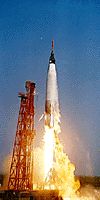
|
Mercury
Atlas 9
MA 9
Faith 7
1963-015A
#00576
(crew: L. Gordon Cooper Jr.) |
Mercury Atlas 9 (MA-9,
Faith 7) was the fourth and final manned orbital flight
of the Mercury program. The pilot was L. Gordon Cooper,
Jr. who was also the main subject of the experiments:
effects of an extended (1 day) stay in space on the
human being. Cooper also became the first to sleep in
orbit. |
May
15th
1963 |
 Enclosed
recording of a comment of L. Gordon Cooper is a courtesy
of NASA. Enclosed
recording of a comment of L. Gordon Cooper is a courtesy
of NASA.
|
 This recording
is from vinyl no. 61 which was included in the Italian
Enciclopaedia L置omo e lo spazio (The man and the space)
issued 1965 by Fratelli Fabbri. Digitized and kindly
provided by Federico Manzini. This recording
is from vinyl no. 61 which was included in the Italian
Enciclopaedia L置omo e lo spazio (The man and the space)
issued 1965 by Fratelli Fabbri. Digitized and kindly
provided by Federico Manzini.
|
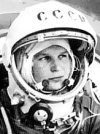
|
Vostok
6
Wostok 6
1963-023A
#00595
(crew: Valentina V. Tereshkova) |
Vostok 6, the last spacecraft
in the USSRs first manned flight series, carried Valentina
V. Tereshkova, the first woman in space. Her flight
lasted for 3 days and, for most of this time, Vostok
6 flew with Vostok 5 maintaining two-way radio communications
and establishing communications with earth at regular
intervals. TV pictures of the cosmonauts in their cabins
were relayed to earth, and a series of biomedical and
scientific experiments were conducted. V. T. Tereshkova
used the callsign "Tschaika" (seagull). After
completing 48 orbits in 70.7 hours, the spacecraft landed
on June 19th 1963. |
June
16th
1963 |
 This recording
is from vinyl no. 64 which was included in the Italian
Enciclopaedia L置omo e lo spazio (The man and the space)
issued 1965 by Fratelli Fabbri. Digitized and kindly
provided by Federico Manzini. This recording
is from vinyl no. 64 which was included in the Italian
Enciclopaedia L置omo e lo spazio (The man and the space)
issued 1965 by Fratelli Fabbri. Digitized and kindly
provided by Federico Manzini.
|
 This recording
was made while V. Tereshkova talked with the Primier
Khrushchev. Recording is part of the compilation "The
Conquest of Space" of the Astronautical Society
of Western Australia and kindly provided by Jos Heymann. This recording
was made while V. Tereshkova talked with the Primier
Khrushchev. Recording is part of the compilation "The
Conquest of Space" of the Astronautical Society
of Western Australia and kindly provided by Jos Heymann.
|
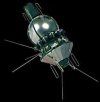
|
Voskhod-1
1964-065A
#00904
(crew: Vladimir M. Komarov, Boris B. Yegorov, Konstatin
P. Feoktisov) |
Voskhod
1, which carried three men into space, was the first
multi-manned flight. The crew members were cosmonauts
Vladimir M. Komarov, command pilot, Boris B. Yegorov,
physician, and Konstatin P. Feoktisov, scientist. This
mission was designed to test the new multi-seat spacecraft,
to investigate the capacity of a group of cosmonauts
who were specialists in different disciplines of science
and engineering, to conduct physical and technical experiments,
and to perform an extensive medical-biological investigation
program. During the flight, live TV pictures were returned.
The life-support systems of the space cabin were felt
to be reliable enough to allow the crew to wear overalls
instead of the cumbersome spacesuits and helmets. The
mission was a success, and a large amount of scientific
data was obtained. |
Oct.
12th
1964 |
 Enclosed
voice transmission from Voskhod-1 was received on 18.035
MHz on October 13th 1964 at
01:55 UTC by R.S. (Dick) Flagg in Gainesville Florida. Enclosed
voice transmission from Voskhod-1 was received on 18.035
MHz on October 13th 1964 at
01:55 UTC by R.S. (Dick) Flagg in Gainesville Florida.
This recording was kindly provided by Sven Grahn with
permission of R.S. (Dick) Flagg.
|
 Voskhod-1
Morse-code, 18.035 MHz, 0155 UT, October 13th
1964, recording by R.S. (Dick) Flagg in Gainesville
Florida. Voskhod-1
Morse-code, 18.035 MHz, 0155 UT, October 13th
1964, recording by R.S. (Dick) Flagg in Gainesville
Florida.
This recording was kindly provided by Sven
Grahn with permission of R.S. (Dick) Flagg.
|
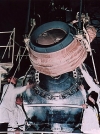
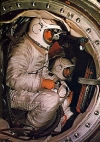

|
Voskhod-2
1965-022A
#01274
(crew: Pawel Iwanowitsch Beljajew, Alexej Archipowitsch
Leonow ) |
Voskhod
2, which carried two men into space, was equipped with
an extendable air lock that permitted Leonov's exit
into space without having to evacuate the main cabin
air. It was the first flight with an extra vehicular
activity (EVA) and cosmonaut Alexej Archipowitsch Leonow
was the first man who left a spacecraft and operated
in free space. The other crew member was commander Pawel
Iwanowitsch Beljajew. The flight of Voskhod 2 lasted
for 26 hours and 16 orbits were completed. A manually
controlled reentry was performed because of a malfunction
of the automatic orientation devices for the retrofire.
The spacecraft landed in a pine forest far north of
the target area. After locating the spacecraft, one
day was required to cut through the forest and bring
the crew out on skis.  Overall
the mission was a success. After Leonow retired he started
to create paintings of his experience in space. Enclosed
is a painting of his EVA. Overall
the mission was a success. After Leonow retired he started
to create paintings of his experience in space. Enclosed
is a painting of his EVA.
Voskhod-2
transmitted voice on 143.625 MHz, 18.035 MHz and 17.365
MHz and had a beacon transmitter on 19.996 MHz. The
143.625 MHz FM transmissions were used for line-of-sight
communications with ground stations while the short-wave
frequencies were used to communicate with the spacecraft
when it was far from Soviet territory. |
March
18th
1965 |
 Enclosed
audio file is from a report about the Voskhod-2 focusing
on the EVA of Alexej Leonow. Supposedly the radio traffic
in the report was recorded during Leonows EVA. Enclosed
audio file is from a report about the Voskhod-2 focusing
on the EVA of Alexej Leonow. Supposedly the radio traffic
in the report was recorded during Leonows EVA.
|
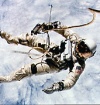
|
Gemini-4
1965-043A
#01390
(crew: James McDivitt, Edward White) |
 Gemini-4
was the second crewed mission of the Gemini series.
It was a 4-day, 62-orbit, 98-hr flight. The recording
was maade during the first American spacewalk performed
by Ed White. Recording is part of the compilation "The
Conquest of Space" of the Astronautical Society
of Western Australia and kindly provided by Jos Heymann. Gemini-4
was the second crewed mission of the Gemini series.
It was a 4-day, 62-orbit, 98-hr flight. The recording
was maade during the first American spacewalk performed
by Ed White. Recording is part of the compilation "The
Conquest of Space" of the Astronautical Society
of Western Australia and kindly provided by Jos Heymann.
|
June 3rd 1965 |
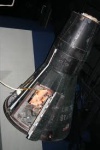
|
Gemini-5
1965-068A
#01516
(crew: Gordon Cooper,"Pete" Charles
Conrad) |
 Gemini
5 was the third crewed Earth-orbiting spacecraft of
the Gemini series. The recording was made while the
crew was passing over Hawaii. Recording is part of the
compilation "The Conquest of Space" of the
Astronautical Society of Western Australia and kindly
provided by Jos Heymann. Gemini
5 was the third crewed Earth-orbiting spacecraft of
the Gemini series. The recording was made while the
crew was passing over Hawaii. Recording is part of the
compilation "The Conquest of Space" of the
Astronautical Society of Western Australia and kindly
provided by Jos Heymann.
|
Aug 21st
1965 |
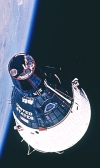
|
Gemini-7
1965-100A
#01812
(crew: James Lovell,
Frank Borman) |
 Gemini 7 was the
fourth crewed Earth-orbiting spacecraft of the Gemini
series, having been launched before Gemini 6A. Its mission
priorities were (1) to demonstrate a 2-week flight,
(2) to perform stationkeeping with the Gemini launch
vehicle stage 2, (3) to evaluate the 'shirt sleeve'
environment and the lightweight pressure suit, (4) to
act as a rendezvous target for Gemini 6, and (5) to
demonstrate controlled reentry close to the target landing
point. The crew members had three scientific, four technological,
four spacecraft, and eight medical experiments to perform. Gemini 7 was the
fourth crewed Earth-orbiting spacecraft of the Gemini
series, having been launched before Gemini 6A. Its mission
priorities were (1) to demonstrate a 2-week flight,
(2) to perform stationkeeping with the Gemini launch
vehicle stage 2, (3) to evaluate the 'shirt sleeve'
environment and the lightweight pressure suit, (4) to
act as a rendezvous target for Gemini 6, and (5) to
demonstrate controlled reentry close to the target landing
point. The crew members had three scientific, four technological,
four spacecraft, and eight medical experiments to perform.
Enclosed 1 hour recording of broadcast reports transmitted
on HF of the successful reentry and landing of Gemini
7 were kindly provided by Rolf Niefind DK2ZF.
|
Dec 4th 1965 |
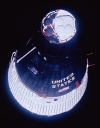
|
Gemini-6A
Gemini-6
1965-104A
#01839
(crew: Walter
Schirra , Thomas Stafford) |
 Gemini
6A was the 5th crewed
Earth-orbiting spacecraft of the Gemini series, having
been launched after Gemini 7, with the intent of making
rendezvous with Gemini 7 in Earth orbit. This mission
was originally designated Gemini 6 and scheduled for
launch on October 25th but
was cancelled when the Agena target vehicle failed to
go into orbit an hour earlier. Gemini 6A was scheduled
to launch on December 12th 1965,
but the launch was aborted one second after engine ignition
because an electrical umbilical separated prematurely.
This was the first time an astronaut mission was aborted
after ignition start. The mission launched successfully
from Complex 19 on December 15th at
13:37 UTC and was inserted into a 161.0 x 259.4 km orbit.
At this point Gemini 6A trailed Gemini 7 by about 1900
km. After several maneuvers rendezvous was technically
achieved with the two Gemini spacecraft in zero relative
motion at a distance of 110 meters. Stationkeeping maneuvers
involving the spacecraft circling each other and approaching
and backing off continued for 5 hours 19 minutes over
three and a half orbits. During the maneuvers, all four
astronauts on both spacecraft took turns in the formation
flying activities and photographs were taken from both
spacecraft. This marked the first time two spacecraft
were maneuvered with respect to each other by their
crews. Near the end of the 15th revolution
the retrorockets were fired and splashdown occurred
at 23.58 N, 67.83 W only 13 km from the target. This
was the first successful controlled reentry to a predetermined
point in the U.S. manned spaceflight program. Gemini
6A was the 5th crewed
Earth-orbiting spacecraft of the Gemini series, having
been launched after Gemini 7, with the intent of making
rendezvous with Gemini 7 in Earth orbit. This mission
was originally designated Gemini 6 and scheduled for
launch on October 25th but
was cancelled when the Agena target vehicle failed to
go into orbit an hour earlier. Gemini 6A was scheduled
to launch on December 12th 1965,
but the launch was aborted one second after engine ignition
because an electrical umbilical separated prematurely.
This was the first time an astronaut mission was aborted
after ignition start. The mission launched successfully
from Complex 19 on December 15th at
13:37 UTC and was inserted into a 161.0 x 259.4 km orbit.
At this point Gemini 6A trailed Gemini 7 by about 1900
km. After several maneuvers rendezvous was technically
achieved with the two Gemini spacecraft in zero relative
motion at a distance of 110 meters. Stationkeeping maneuvers
involving the spacecraft circling each other and approaching
and backing off continued for 5 hours 19 minutes over
three and a half orbits. During the maneuvers, all four
astronauts on both spacecraft took turns in the formation
flying activities and photographs were taken from both
spacecraft. This marked the first time two spacecraft
were maneuvered with respect to each other by their
crews. Near the end of the 15th revolution
the retrorockets were fired and splashdown occurred
at 23.58 N, 67.83 W only 13 km from the target. This
was the first successful controlled reentry to a predetermined
point in the U.S. manned spaceflight program.
Enclosed
recordings of broadcast reports transmitted on HF of
the initial aborted, the following successful launch
of Gemini 6A and the rendezvouz of Gemini-6A and Gemini-7
were kindly provided by Rolf Niefind DK2ZF.
|
Dec 15th 1965 |
Picture |
Object
name
#NORAD |
Description |
Mission
Date |